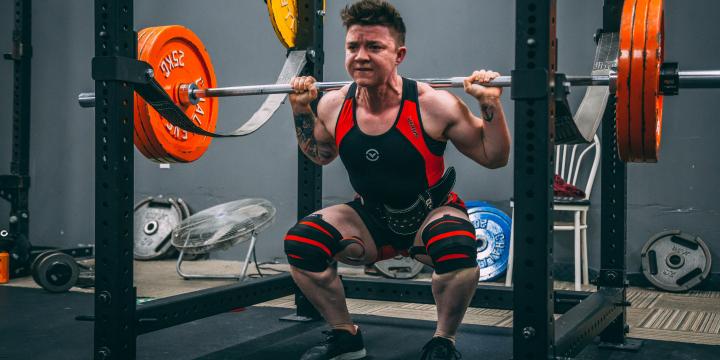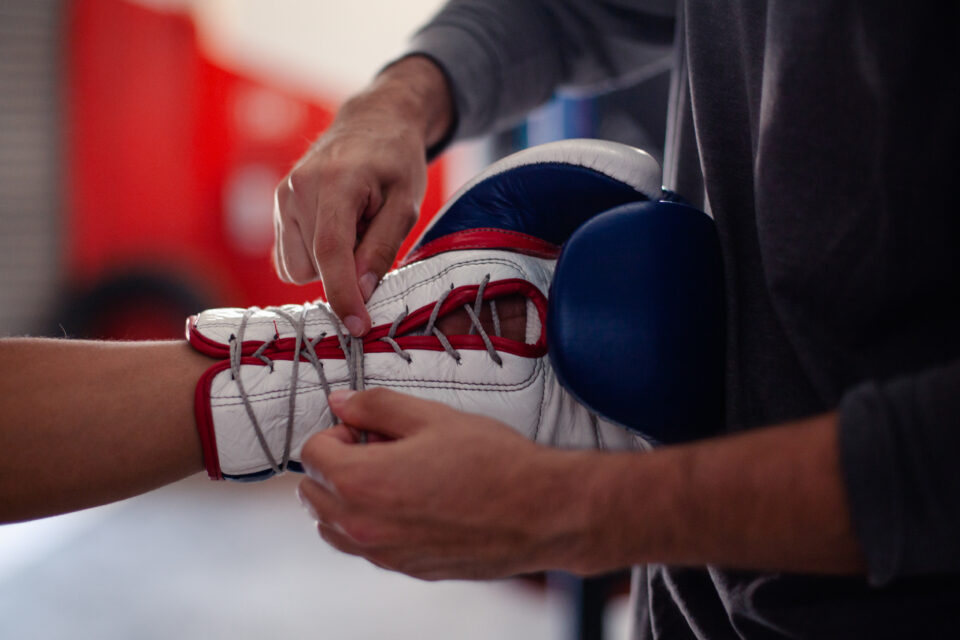Powerlifters are some of the strongest athletes on the planet. Squatting, benching, and deadlifting hundreds, if not thousands, of pounds are the norm in this sport. We could assume, as a boxer, becoming as strong as a powerlifter will translate into knockout power.
But is that the case? Wouldn’t strength athletes that cross over to boxing be unstoppable? While getting stronger has its advantages, there are inherent cons when undertaking a powerlifting routine for boxing.
Pros of Powerlifting For Boxing
When done, powerlifting can be a viable option for boxing strength training, with boxing being the number one priority in mind. Here are six epic advantages of powerlifting for boxing.
1. Enhance Lower Body Strength
Boxing may seem like an upper-body dominant sport. But the legs play a crucial role in punching power. One of the earliest research papers shows that boxers that punch the hardest have the most significant leg contribution.
Powerlifting’s two main lower body lifts are the squat and deadlift. These two staple compound exercises build tremendous strength in the legs.
Key point: By improving the force produced by the lower body, you can potentially transfer this newfound strength into your punch.
2. Release The Brakes
A lesser-known adaptation to heavy strength training, we have a sensor called the Golgi tendon organ (or GTO for short) within the tendon. The GTO is like a handbrake. When it senses muscular force production is too much for the muscle to handle, it pumps the brakes to reduce your force output.
Essentially, it’s protecting your muscles from tearing. However, the GTO kicks in very early within lesser trained individuals, reducing the force they can produce. Hence, when beginners start lifting weights, they can do so relatively frequently compared to an advanced lifter as they can’t produce maximal force outputs.
Key point: Maximal strength training by powerlifting desensitizes the GTO, delaying when the brakes start. Therefore, allowing you to produce more force during other activities.
3. Increase Tendon Stiffness
Tendon stiffness is a prerequisite adaptation needed for explosiveness. Think of a tendon-like spring. We’ll use the Achilles tendon as an example. When bouncing around the ring or making quick, reactive movements, you need to respond rapidly to the feedback from the ground.
To illustrate this point, think about compressing a small loose spring. As you release it, it quickly springs to its original form and pops off the floor. However, take a sizable stiff spring and compress it. When released, it violently springs off the floor.
Key point: A stiff Achilles tendon will give you better “springs” so you can take advantage of elastic energy, which has energy-saving and power-enhancing benefits.
4. Raise The Ceiling
Becoming explosive is not solely about speed-based exercises. A strength base is needed to underpin explosive qualities. While you only have milliseconds to display high levels of force in boxing, if you can’t produce that force in longer time frames, you can’t produce it in shorter time frames.
Improving maximal strength raises your force production ceiling giving you the potential to enhance force production in shorter time frames. Further, you develop strength reserve. Strength reserve is simply having more in the tank than you need.
For example, if boxer A can squat 225 lbs while boxer B can squat 135 lbs when they are both doing a 100 lb squat, boxer B will fatigue first as it is closer to his maximum weight. Boxer A has a greater strength reserve, so the 100 lb squat is easier.
Key point: This is an important concept even in boxing, as the clinch can be draining if you constantly carry your opponent’s body weight.
5. Reduce The Risk Of Injury
Research shows that strength training is a successful component to reducing the risk of injury. Simply being stronger can reduce the injury risk by approximately 66%. Lifting with a full range of motion can develop strength and long muscle lengths where injury commonly occurs.
6. Get Stronger Without Adding Size
Boxing is a weight class sport. Unnecessary muscle mass makes it harder to cut. As there is a dose-response relationship between training volume and adding muscle mass (i.e., the more volume, the greater the muscle growth), low volume powerlifting routines can minimize weight gain.
Especially if daily caloric intake is at maintenance. Let’s compare a typical powerlifting and bodybuilding-style program. One program focuses on building strength. In contrast, the other focuses on muscle hypertrophy (muscle growth), which is why powerlifters are stronger than bodybuilders, even at much smaller sizes.
Key point: Powerlifting can help you improve your strength without adding mass, unlike bodybuilding.
Cons of Powerlifting For Boxing
It’s not all roses and sunshine regarding powerlifting and boxing. If taken too far, powerlifting can be detrimental to your boxing performance. Here are four reasons why.
1. Minimal Explosive Training
Specialized powerlifting programs typically don’t have any explosive or speed training. Westside dynamic effort bench press with 60% 1RM does not count as speed and power training for sports like boxing.
It is still too slow. I’m talking about jumps, throws, and plyometrics by explosive training. These aren’t important for Powerlifters as their goal isn’t to produce force as quickly as possible but to move the heaviest weight possible regardless of time.
Key point: If all your boxing weight training is following a powerlifting program, you are missing out on key physical development through speed and power training.
2. Doesn’t Take Into Account Force Vectors
Bret Contreras first wrote about the force vector theory, and has been explored within the sprint training world. The general premise is performing exercises where force is applied in the same direction as the competition exercise will transfer better.
For example, if you want to jump higher, you’ll perform exercises like the squat where the movement is vertical. However, when needing to apply large forces horizontally or laterally, you may use various sledge drag variations as an example.
Vertical force production is vital for boxing as the legs generate the force needed for knockout power. However, performing vertical exercises typical in a powerlifting routine may leave you physically underdone.
Key point: A heavy rotation element in boxing cannot be understated and wholly neglected within a powerlifting program.
3. Too Much Can Slow You Down
A myth persists around traditional boxing cultures that says lifting weights will make you slow. But this entirely depends on how you go about it. If you use a pure powerlifting routine, it won’t hamper your speed in the beginning.
Developing a base level of strength will always make you faster. But as you get stronger and you need more volume to progress, lifting will start to take its toll. Further, with no speed or power training in the gym, you’re solely training to improve maximal strength, which stimulates the opposite adaptations to speed.
For example, powerlifting will increase muscular activation of the primary muscle working in an exercise throughout the entire range of motion. Initially, it sounds like a great adaptation; however, like boxers, we want to produce force as quickly as possible, not gradually increasing force production throughout a movement.
Another example is the increase in muscular co-contractions around a joint. Opposing muscle groups contract together, a great protective mechanism for joints. However, it’s horrible for speed.
Key point: Elite-level athletes often aren’t faster or more powerful because they produce more force. But because they can relax antagonist muscles faster than their opponents.
4. High Volumes Will Negatively Affect Boxing Training
I’m sure you’ve made this mistake at some point in your boxing training. Perhaps you hit the gym for an epic bench day. So, you bench press, follow it up with higher rep dumbbell work, then smoke your triceps to finish the day.
You head to boxing training the following day with your chest, shoulders, and triceps unbelievably sore. If not sore, slightly weary. You start hitting the pads or bag, and your shoulders and arms are screaming at you. It is a consequence of performing too much volume in the gym.
Key point: The entire premise of strength training for boxing is to complement your boxing training. Meaning it mustn’t significantly impair technical boxing training. Too much, and it will.
Example Powerlifting Routine For Boxing
An example is a three-day-per-week strength training program with a powerlifting influence. Because powerlifting workout splits are typically high volume, this will take some of the exercises and principles from powerlifting and adapt them to boxing.
Squat Day
A1) Box Jump 3 x 5
B1) Barbell Squat Jump 3 x 3 @20-40% 1RM
C1) Back Squat 3 x 4 @80% 1RM
D1) Single Leg RDL 3 x 8/leg @8 RPE
E1) 4-Way Neck Isometric 3 x 10 sec/side
Bench Day
A1) Explosive Medicine Ball Chest Pass 3 x 5
B1) Bench Press 3 x 4 @83% 1RM
C1) Chin-Up 3 x 6
D1) Bottoms Up Kettlebell Overhead Press 3 x 8/side
E1) Inverted Row 3 x 10
F1) Landmine Rotation 3 x 5/side
Deadlift Day
A1) Med Ball Scoop Toss 3 x 3
B1) Explosive Back Extension 3 x 6
C1) Deadlift 3 x 3 @80% 1RM
D1) Bulgarian Split Squat 3 x 6/leg
E1) 4-Way Neck Flexion/Extension 3 x 15-20/side
Want to try powerlifting? Or boxing? Join a free boxing class today or get your free personal training session with The BXNG Club. test





